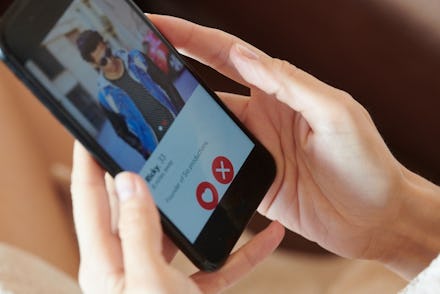The psychology behind why we speed swipe on dating apps

Back when I was still a single Tinderella, my co-workers and I would trade war stories from our evenings on the swipey. Once, as I lamented a dearth of matches, a male co-worker told me to chill and follow his example: Swipe right every time. “You do that?” I balked. “Every guy does,” he said. Did they, though? Was life really just one big gendered cliché, with men who took whatever they could get, and pearl-clutching women who waved off suitor after suitor? I wondered if my colleague an anomaly or if one gender is indeed more likely to thoughtlessly and continuously speed swipe on Tinder.
A study published earlier this month in Frontiers in Psychology suggests our real-life dating behavior is more nuanced. Researchers at Northwestern University’s Kellogg School of Management and the MIT Media Lab collected data from 100,000 heterosexual users (50,000 women and 50,000 men) of the dating app Hinge from before November 2015, when users could swipe a maximum of 21 times a day, as part of a larger study on what makes people swipe right on each other. They observed the longest “yes” streaks (consecutive right-swipes) and “no” streaks (consecutive left-swipes) among male and female users.
Among women, the longest “yes” streaks involved swiping right on about 46 men in a row, on average. But women rarely went on “yes” streaks. Only 1.3% of women spent their longest streak saying “yes,” while 43.1% spent their longest streak saying “no.” On average, the longest “no” streaks involved swiping left on about 37 men in a row. In other words, women were more likely to binge-swipe left.
But contrary to what my coworker believed, men weren’t more likely to binge-swipe right. In fact, the findings suggest they were just as likely to binge-swipe left as they were to binge-swipe right, with 24% spending their longest streak saying “no,” and 26% spending it saying “yes.” During their “no” streaks, they swiped through about 30 women, on average.
Men and women also differed in how long they spent sizing up each potential mate, but, again, not in the ways my coworker thought. Women spent hardly any time on the profiles of men they found attractive — 3.19 seconds, on average — before swiping right on them. But they spent more than twice as much time on less-appealing candidates — 6.91 seconds, on average — before swiping left. So they basically hesitated at least a little before rejecting a potential dude.
And while my coworker made it seem like dudes blindly swipe right on every profile, barely glancing at any of them, it actually turns out that men are much more consistent in the decision-making process overall, Jon Levy, a study co-author and research associate at the Kellogg School of Management, tells Mic. Men spent about the same amount of time — 5.7 and 6.26 seconds, on average — on the profiles of women they found attractive and unattractive, respectively.
Levy adds that these findings might also suggest that men tend to have more of a consensus on what they consider attractive than women do. That women lingered so long on profiles of men they weren’t attracted to suggests they may have wanted to search for a reason to swipe right on them, Levy explains.
Indeed, women took an average of 8.7 seconds to swipe right on someone most other women had rejected. “I think that when there’s a lack of certainty, there’s a desire for more information,” Levy says. “’Let me put some thought into this, let me find more data.’”
That was more or less my experience on Tinder. “Maybe he’s just not photogenic,” I’d think to myself when I stumbled on someone I felt “meh” about. “Maybe cross-referencing his Instagram will give me a better sense of him beyond his profile.” I rarely swiped left outright.
Men, on the other hand, took only 5.23 seconds on average to swipe right on someone most other men had turned down. The study results suggest that “men and women make decisions differently, but not in the way we expect,” Levy says. Women’s tendency to spend more time deliberating over someone they’re unsure of aligns with the stereotype of them being more open-minded and discerning when it comes to choosing a mate — but the finding that men are as likely to spend their longest binge swiping left as they are to spend it swiping right suggests they have these qualities, too, even if their decision-making process might differ.
“There’s a lot of stuff we believe about our behavior that just isn’t true,” Levy says. “Hopefully by becoming aware of it, we can move past it so we can find better relationships.”